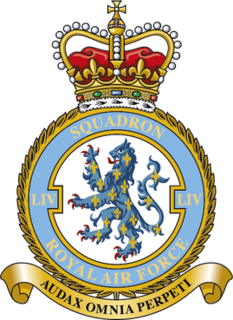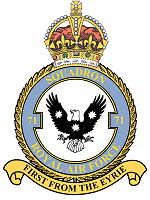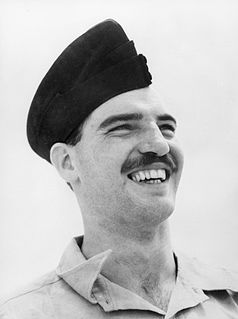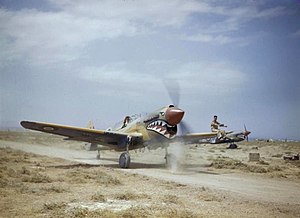
The Curtiss P-40 Warhawk is an American single-engined, single-seat, all-metal fighter and ground-attack aircraft that first flew in 1938. The P-40 design was a modification of the previous Curtiss P-36 Hawk which reduced development time and enabled a rapid entry into production and operational service. The Warhawk was used by most Allied powers during World War II, and remained in frontline service until the end of the war. It was the third most-produced American fighter of World War II, after the P-51 and P-47; by November 1944, when production of the P-40 ceased, 13,738 had been built, all at Curtiss-Wright Corporation's main production facilities at Buffalo, New York.

The Desert Air Force (DAF), also known chronologically as Air Headquarters Western Desert, Air Headquarters Libya, the Western Desert Air Force, and the First Tactical Air Force (1TAF), was an Allied tactical air force created from No. 204 Group RAF under RAF Middle East Command in North Africa in 1941 to provide close air support to the British Eighth Army against Axis forces. Throughout the Second World War, the DAF was made up of squadrons from the Royal Air Force (RAF), the South African Air Force (SAAF), the Royal Australian Air Force (RAAF), the United States Army Air Forces (USAAF) and other Allied air forces.

Number 17 Squadron, currently No. 17 Test and Evaluation Squadron (TES), is a squadron of the Royal Air Force. It was reformed on 12 April 2013 at Edwards Air Force Base, California, as the Operational Evaluation Unit (OEU) for the Lockheed Martin F-35B Lightning.

Number 23 Squadron is a squadron of the Royal Air Force responsible for 'day-to-day space operations', having been reformed in January 2021, as the first "space squadron".. Up until its disbandment in October 2009, it operated the Boeing Sentry AEW1 Airborne Warning And Control System (AWACS) aircraft from RAF Waddington, Lincolnshire.

Number 3 Squadron, also known as No. 3 (Fighter) Squadron, of the Royal Air Force operates the Eurofighter Typhoon FGR4 from RAF Coningsby, Lincolnshire, since reforming on 1 April 2006. It was first formed on 13 May 1912 as one of the first squadrons of the Royal Flying Corps – being the first to fly heavier than air aircraft.

Number 25 (Fighter) Squadron is squadron of the Royal Air Force, having reformed on 8 September 2018.

Number 111 (Fighter) Squadron, also known as No. CXI (F) Squadron and nicknamed Treble One, was a squadron of the Royal Air Force. It was formed in 1917 in the Middle East as No. 111 Squadron of the Royal Flying Corps during the reorganisation of the Egyptian Expeditionary Force after General Edmund Allenby took command during the Sinai and Palestine Campaign. The squadron remained in the Middle East after the end of the First World War until 1920 when it was renumbered as No. 14 Squadron.

Number 54 Squadron is a squadron of the Royal Air Force based at RAF Waddington, Lincolnshire. On 1 September 2005, it took on the role of Intelligence, Surveillance and Reconnaissance (ISR) Operational Conversion Unit, and is currently responsible for training all RAF crews assigned to the Sentry AEW1, Sentinel R1, Shadow R1, RC-135W Rivet Joint and Poseidon MRA1. It also runs the Qualified Weapons Instructor Intelligence, Surveillance and Reconnaissance Course.

Number 56 Squadron, nicknamed the Firebirds for their ability to always reappear intact regardless of the odds, is one of the oldest and most successful squadrons of the Royal Air Force, with battle honours from many of the significant air campaigns of both the First and Second World Wars.

No. 3 Squadron is a Royal Australian Air Force (RAAF) fighter squadron, headquartered at RAAF Base Williamtown, near Newcastle, New South Wales. Established in 1916, it was one of four combat squadrons of the Australian Flying Corps during World War I, and operated on the Western Front in France before being disbanded in 1919. It was re-raised as a permanent squadron of the RAAF in 1925, and during World War II operated in the Mediterranean Theatre. The Cold War years saw the squadron disbanded and re-raised twice. It was based at RAAF Butterworth during the Malayan Emergency and the Indonesia–Malaysia Konfrontasi. Equipped with McDonnell Douglas F/A-18 Hornet multi-role fighters from 1986, the squadron deployed to Diego Garcia in 2002 to provide local air defence, and the following year contributed aircraft and crews to the invasion of Iraq as part of Operation Falconer. In April 2016, it deployed to the Middle East as part of the military intervention against ISIL.

Number 19 Squadron was a flying squadron of the Royal Air Force. Formed on 1 September 1915 as a Royal Flying Corps squadron, the unit served during the First World War. No. 19 Squadron was the first squadron in the RAF to operate the Supermarine Spitfire on 4 August 1938, which it flew for the majority of the Second World War. The squadron operated several different types during the Cold War from the Gloster Meteor F.4 to the McDonnell Douglas Phantom FGR.2 as No. 19 (Fighter) Squadron. From September 1992 until November 2011, the unit was designated No. 19 (Reserve) Squadron. The unit most recently operated the BAe Hawk T.1, T.1A and T.2 from RAF Valley until it was disbanded on 24 November 2011.

Number 92 Squadron, also known as No. 92 Squadron and currently as No. 92 Tactics and Training Squadron, of the Royal Air Force is a test and evaluation squadron based at RAF Waddington, Lincolnshire. It was formed as part of the Royal Flying Corps at London Colney as a fighter squadron on 1 September 1917. It deployed to France in July 1918 and saw action for just four months, until the end of the war. During the conflict it flew both air superiority and direct ground support missions. It was disbanded at Eil on 7 August 1919. Reformed on 10 October 1939, the unit was supposed to be equipped with medium bombers but in the spring of 1940 it became one of the first RAF units to receive the Supermarine Spitfire, going on to fight in the Battle of Britain.

No. 71 Squadron was a Royal Air Force aircraft squadron. The number has been used three times: once by the Royal Flying Corps for an Australian Flying Corps squadron; in the Second World War as the first of three Eagle Squadrons; and post-war as a fighter-bomber unit under the command of Royal Air Force Germany.
No. 225 Squadron RAF is a former Royal Air Force squadron.

No. 616 Squadron is an active Reserve unit of the Royal Auxiliary Air Force (RAuxAF) assigned to the RAF ISTAR Force at RAF Waddington. It was originally formed as a unit of the British Auxiliary Air Force in 1938, active throughout World War 2 as a fighter unit, becoming the 1st operational RAF unit to fly jets and disbanded in 1957. The unit reformed in its current guise in April 2019 as 616 Squadron Royal Auxiliary Air Force.

No 605 Squadron was formed as an Auxiliary Air Force Squadron. Initially formed as a bomber unit, it was one of the most successful participants of the Battle of Britain. It also had the distinction of being active during the Second World War at two fronts at a time, when the squadron was split up between Malta and the Dutch East Indies. In its last incarnation as an active flying unit, the squadron served as the first jet fighter unit in the post-war Royal Auxiliary Air Force; 616 having already flown Gloster Meteors during the war. No. 605 Squadron was reformed as a RAuxAF Logistic Support Squadron (LSS) on 1 Nov 2014 within No. 85 Expeditionary Logistics Wing of the RAF A4 Force. On the 1 January 2019, the Reserve Logistic Support Wing (RLSW) was established with 501, 504 and 605 LSS Squadron's moving from No. 85 Wing RAF to form RLSW.
No. 268 Squadron RAF was a Second World War Royal Air Force squadron that operated the North American Mustang on missions over occupied Europe and in support of the D-Day landings.
No. 260 Squadron RAF was a Royal Air Force squadron formed as a reconnaissance and anti–submarine unit in World War I and a fighter unit in World War II.

5 Squadron SAAF was a South African Air Force Fighter / Fighter-Bomber squadron during World War II. It was disbanded at the end of the war and was re-commissioned in 1950. It remained active until 2 October 1992, when it was disbanded; its Atlas Cheetah E aircraft were also decommissioned.

Alan Charles Rawlinson, was an Australian airman who became a fighter ace in World War II. He was credited with at least eight aerial victories, as well as two aircraft probably destroyed, and another eight damaged. Born in Fremantle, Western Australia, Rawlinson joined the Royal Australian Air Force in 1938. He was posted to the Middle East in July 1940 and saw action with No. 3 Squadron, flying Gloster Gladiator and Gauntlet biplanes initially, and later Hawker Hurricanes and P-40 Tomahawks. Twice credited with shooting down three enemy aircraft in a single sortie, he was awarded the Distinguished Flying Cross (DFC) in October 1941 and took command of No. 3 Squadron the next month. He received a bar to his DFC in December 1941, and returned to Australia in March 1942.






















